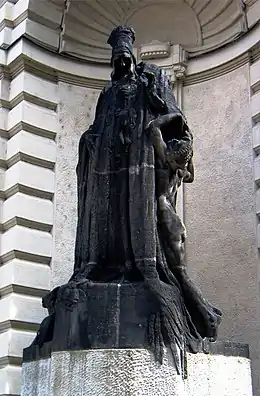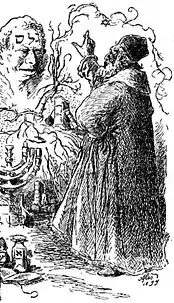Judah Loew ben Bezalel
Judah Loew ben Bezalel (hebreeraz: יהודה ליווא בן בצלאל) (1512 eta 1526 artean – 1609ko irailaren 17an)[1], Loew, Löw, Loewe, Löwe edo Levai Errabinoa, Pragako Maharala (hebreeraz מהר״ל מפראג), edo Maharala, Talmudaren akademiko, mistiko judu eta filosofoa zen, Mikulov (Moravia) eta Praga (Bohemia) hirietako errabinoa izateaz gain.[2][3]
| Judah Loew ben Bezalel | |||||
|---|---|---|---|---|---|
 | |||||
1553 (egutegi gregorianoa) - 1573 (egutegi gregorianoa)
| |||||
| Bizitza | |||||
| Jaiotza | Poznań, 1520 | ||||
| Heriotza | Praga, 1609ko irailaren 17a (88/89 urte) | ||||
| Hobiratze lekua | Pragako antzinako hilerri judutarra | ||||
| Familia | |||||
| Seme-alabak | ikusi
| ||||
| Ikaslea(k) | ikusi
| ||||
| Jarduerak | |||||
| Jarduerak | errabinoa, matematikaria eta filosofoa | ||||
| Lantokia(k) | Praga Poznań eta Mikulov | ||||
| Sinesmenak eta ideologia | |||||
| Erlijioa | judaismoa | ||||
Izena
Maharalaren izenak ("Löw" edo "Loew") alemanezko Löwe "lehoi" hitzetik eratorriak dira, (cf. "Levai") Leib yiddish hitzaren antzera. Izen hauek hebreerazko "Juda" edo Yehuda izenaren kinui edo ordezko izenak dira,[4][5] Hebrear Bibliaren arabera Judah-ren tribuaren izena, eta lehoiarekin ikurrarekin erlazionatua.[6]
Genesiaren liburuan, Jakob aitalehena bere seme Judarengana "Lehoi Gazte" (Gur Aryeh) bezala zuzendu zen bedeikatu zuenean.[7]
Familia eta ondorengoak
Maharalaren familia, Perla Shmelkes (? - 1610) emazteak, sei alabak eta seme batek osatzen zuten. Semea, Bezalel (? - 1600), errabinoa bilakatu zen Kolínen.[8][9][10]
Lanak
- Gur Aryeh ("Lehoi Gaztea", Praga 1578).[11]
- Gevuroth Hashem ("Jainkoaren Ekintza Ahaltsuak", Krakovia 1582).[12]
- Derech Chaim ("Bizimodua", Krakovia 1589).[13]
- Derashot ("Sermoiak", Praga 1589 eta 1593).[14]
- Netivoth Olam ("Munduko Bidezidorrak", Praga 1595-1596).[15]
- Be'er ha-Golah ("Erbesteko Putzua", Praga 1598).[16]
- Netzach Yisrael ("Israeleko betikotasuna", Praga 1599). Netzach "betikotasun" hitzak, garaipen hitzaren erro bera du.[17]
- Tif'ereth Yisrael ("Israelen Aintza", Venezia 1599).[18]
- Or Chadash ("Argi berri bat", Praga 1600).
- Ner Mitzvah ("Aginduaren Kandela", Praga 1600).[19]
- Chiddushei Aggadot ("Aggadaren Nobela"). XX. mendean aurkitu zen.
- Divrei Negidim ("Errektoreen Hitzak", ca.1895 - ca.1925). Yudel Rosenberg errabinoak argitaratu zuen, Pesaj-eko prozedurari (Seder Pesach, סדר) buruz; Maharalaren hitzetan oinarriturik eta bere ideiak bateratuz.[20]
Golem kondaira
Golema (hebreeraz: גולם) judu mitologia eta folkloreko izaki animatu antropomorfikoa da, material bizigabez (normalean buztina edo lohia) egina.[21][22][23]
Golemaren istorio zaharrenak judaismo goiztiarrera (OAA VI. mendea - OA 70) datatzen dira. Talmudeko Sanedrin Tratatuan (Sanedrin 38b) aipatzen da nola Adam hasiera batean golem bat bezala sortu zen, bere hautsa "forma gabeko oskola batean" bateratu zenean.[24] Golemak izaki antropometrikoak izan arren, ez dira gizaki bilakatzen. Hasiera batean, golemaren ezgaitasun nagusia, hitz egiteko ezintasuna zen.[25]
Erdi Aroan Sorkuntzaren Liburua (Sefer Yetzirah) aztertu zen.[26][27]
Golemaren kontakizun ezagunena Judah Loew errabinoarena da, .[28][29]
Historialari eta kritikoen ikuspegitik Golemaren kondaira XIX. mende hasierako asmakizun literario alemaniarra izan zen. Ezagutzen diren lehen idatzizko iturriak autore alemaniar-judutarren eskutikoak dira;[30] besteak beste, Friedrich Korn-en Der Jüdische Gil Blas (1834),[31][32][33] Berthold Auerbach-en Spinoza (1837), Gustav Philippson-en Der Golam, eine Legende (1841), Franz Klutschak-en Der Golam des Rabbi Löw (1841), Adam Tendlau-ren Der Golem des Hoch-Rabbi-Löw (1842) eta Leopold Weisel-en Der Golem (1847).[33][34]
Herri-kulturan
Artelanak
Film eta telebistan
- Paul Wegener zuzendariaren trilogia, Judah Loew errabinoaren eta bere golem-aren inguruan eginiko lehen filmek osatua.[35]
Gobernu eta erakundeak
- 1997ko apirilean, Txekiar Errepublikak eta Israelek errabinoaren hilarria zuten seiluak plazaratu zituzten elkarrekin.[39][40]
- 2007an, UNESCOk Maharaalren ohorezko ospakizunak antolatu zituen.[41]
- 2009ko maiatzean, Txekiar posta zerbitzuak Loew-ren heriotzaren 400. urteurrenaren ohorez seilu berezia sortu zuen.
- 2009ko apirilean, Txekiar txanpon etxeak txanpon berezia atera zuten, 400. urteurrenaren ohorez.
Ikusi,
- Adlerstein Y. Be'er Hagolah: The Classic Defense of Rabbinic Judaism Through the Profundity of the Aggadah. New York, NY: Mesorah Publications, 2000. ISBN 1-57819-463-6.[42]
- Aharon Kleinberger, The Educational Theory of the Maharal of Prague [Hebrew] (Magnes: 1962).
- Andre Neher, Jewish Thought and the Scientific Revolution: David Gans (1541–1613) and his times (Oxford-New York: Littman Library, 1986).
- Benjamin Gross, Netzah Yisrael (Tel Aviv: Devir, 1974)
- Byron L. Sherwin, Mystical Theology and Social Dissent: The Life and Works of Judah Loew of Prague (Fairleigh Dickinson University Press, 1982).
- Byron L. Sherwin, (2001). «THE LEGACY OF RABBI JUDAH LOEW OF PRAGUE» European Judaism: A Journal for the New Europe 34 (1): 124–130. ISSN 0014-3006. [43]
- David Gans, 1541-1613 : disciple du Maharal, assistant de Tycho Brahe et de Jean Kepler (1974; David Gans, 1541-1613 : disciple of Maharal, assistant of Tycho Brahe and of Johannes Kepler) ISBN 2-252-01723-6.[44]
- English translation as Jewish thought and the scientific revolution of the sixteenth century : David Gans (1541-1613) and his times (1986) OUP. ISBN 978-0-19-710057-8.[45]
- Eliyahu Yaakov Deutsch, Shabbos Insights Of The Maharal Jerusalem: Targum, 2009.
- Gregor Brand (2008). "Löw, Juda (Yehuda, Jehudah, Yudah, Judah) ben Bezalel (auch Löwe, Löb, Livia, Liwa etc., Akronym: "MaHaRaL")". In Bautz, Traugott (ed.). Biographisch-Bibliographisches Kirchenlexikon (BBKL) (in German). Vol. 29. Nordhausen: Bautz. cols. 858–877. ISBN 978-3-88309-452-6.[46]
- Gross, Benjamin, Yehi Or (Reʾuven Mass, 1995).
- Gross, Benjamin, Netsah Yiśraʾel Tel Aviv : Devir, 1974.
- Martin Buber, "The Beginning of the National Idea" On Zion: The History of an Idea. (New York, Schocken Books, 1973).
- Mordechai Breuer, "The Maharal of Prague's Disputation with Christians: A Reappraisal of Be'er Ha-Golah" in Tarbiẕ (1986) 253-26.
- Moshe Zuriel "Numbers: Their meaning and Symbolism According to Maharal" [Hebrew] HaMaayan 18:3 (1978) 14–23; 18:4 (1978) 30–41, reprinted in Sefer Ozrot Gedolei Yisroel (Jerusalem:2000) volume 1, pp. 204–228.
- Neher, Faust et le Maharal de Prague: le Mythe et le Reel (Paris: Presses Universitaires de France, 1987).
- Neher, Le Puits de l'Exil: la Theologie Dialectique du Maharal de Prague (Paris: A. Michel, 1996).[47]
- Neher, Mishnato shel ha-Maharal mi-Prague, Reʾuven Mass, c2003.
- Otto Dov Kulka, "The Historical Background of the National and Educational Teachings of the Maharal of Prague" [Hebrew] Zion 50 (1985) 277–320.
- Shulman, Yaacov Dovid (1992). The Maharal of Prague: The Story of Rabbi Yehudah Loew. CIS Publishers. ISBN 978-1-56062-168-3.[48]
- Rivka Schatz Uffenheimer, "Maharal's Conception of Law- Antithesis to Natural Law" Jewish Law Annual Vol. VI.
- Rivka Schatz Uffenheimer, "Existence and Eschatology in the Teachings of the Maharal" Immanuel 14 (Spring 1982) 66–97; Immanuel 15 (Winter 1982-3) 62–72.
- Vajda, Georges. (1967). «André Neher. Le puits de l'exil. La théologie dialectique du Maharal de Prague» Revue de l'histoire des religions 171 (2): 229–234.
Erreferentziak
- «JUDAH LÖW (LÖB, LIWA) BEN BEZALEEL - JewishEncyclopedia.com» jewishencyclopedia.com (Noiz kontsultatua: 2022-07-12).
- «Ancestors of the Maharal of Prague» www.loebtree.com (Noiz kontsultatua: 2022-07-26).
- (Ingelesez) «Torah.org» Torah.org 2017-02-06 (Noiz kontsultatua: 2022-07-26).
- Potok, Chaim. Wanderings: History of the Jews. Ballantine Books, New York, 1978
- Telushkin, Joseph. Jewish literacy. William Morrow and company, New York, 1991.
- (Ingelesez) «Bible Gateway passage: Judges 1:1-2 - New King James Version» Bible Gateway (Noiz kontsultatua: 2022-07-27).
- (Ingelesez) «Génesis 49:9 - Bible Gateway» www.biblegateway.com (Noiz kontsultatua: 2022-07-27).
- «Ancestors of the Maharal of Prague» www.loebtree.com (Noiz kontsultatua: 2022-07-26).
- «Descendants of Rabbi JUDAH LOEW» www.heymannfamily.com (Noiz kontsultatua: 2022-07-26).
- Polakovic, Daniel. Judah Loew ben Bezalel, called Maharal. A Study on His Genealogy and Biography. (Noiz kontsultatua: 2022-07-26).
- (Ingelesez) «Torah.org» Torah.org 2019-06-26 (Noiz kontsultatua: 2022-07-12).
- «Gevurot Hashem» www.sefaria.org (Noiz kontsultatua: 2022-07-26).
- «Derekh Chayim» www.sefaria.org (Noiz kontsultatua: 2022-07-26).
- «Drashot Maharal» www.sefaria.org (Noiz kontsultatua: 2022-07-26).
- «Netivot Olam» www.sefaria.org (Noiz kontsultatua: 2022-07-26).
- «Be'er HaGolah» www.sefaria.org (Noiz kontsultatua: 2022-07-26).
- «Netzach Yisrael» www.sefaria.org (Noiz kontsultatua: 2022-07-26).
- «Tiferet Yisrael» www.sefaria.org (Noiz kontsultatua: 2022-07-26).
- «Ner Mitzvah» www.sefaria.org (Noiz kontsultatua: 2022-07-26).
- «Divrei Negidim on Pesach Haggadah» www.sefaria.org (Noiz kontsultatua: 2022-07-26).
- Idel, Moshe. (1990). Golem : Jewish magical and mystical traditions on the artificial anthropoid. State University of New York Press ISBN 0-585-08857-8. PMC 42856278. (Noiz kontsultatua: 2022-07-26).
- (Gaztelaniaz) «Leyendas del rabino Löw y su Golem» Radio Prague International 2004-08-28 (Noiz kontsultatua: 2022-07-26).
- (Ingelesez) Patai, Raphael. (2015-03-26). Encyclopedia of Jewish Folklore and Traditions. Routledge ISBN 978-1-317-47171-4. (Noiz kontsultatua: 2022-07-26).
- «Sanhedrin 38b» www.sefaria.org (Noiz kontsultatua: 2022-07-26).
- «Sanhedrin 65b» www.sefaria.org (Noiz kontsultatua: 2022-07-26).
- Trachtenberg, Joshua. (2004). Jewish magic and superstition : a study in folk religion. University of Pennsylvania Press ISBN 1-283-89881-0. PMC 843080489. (Noiz kontsultatua: 2022-07-26).
- «GOLEM - JewishEncyclopedia.com» www.jewishencyclopedia.com (Noiz kontsultatua: 2022-07-26).
- (Ingelesez) elisniv. (2011-02-01). «The Golem in the Attic» Moment Magazine (Noiz kontsultatua: 2022-07-26).
- (Ingelesez) Bilefsky, Dan. (2009-05-10). «Hard Times Give New Life to Prague’s Golem» The New York Times ISSN 0362-4331. (Noiz kontsultatua: 2022-07-26).
- (Ingelesez) Gelbin, Cathy S.. (2011). The Golem Returns: From German Romantic Literature to Global Jewish Culture, 1808-2008. University of Michigan Press ISBN 978-0-472-11759-8. (Noiz kontsultatua: 2022-07-26).
- Populäres Judentum : Medien, Debatten, Lesestoffe. Niemeyer 2009 ISBN 978-3-484-97104-2. PMC 497897786. (Noiz kontsultatua: 2022-07-26).
- «Der j�dische Gil Blas von Joseph Seligmann Kohn - Text im Projekt Gutenberg» web.archive.org 2015-09-27 (Noiz kontsultatua: 2022-07-26).
- (Alemanez) Der jüdische Gil Blas / hrsg. u. mit Anmerkungen begleitet v. einem Unbefangenen [Selig Korn. ] 1834 (Noiz kontsultatua: 2022-07-26).
- (Gaztelaniaz) «Der Jüdische Gil Blas 1834 | PDF» Scribd (Noiz kontsultatua: 2022-07-26).
- «Containing the Monster: The Golem in Expressionist Film and» paperzz.com (Noiz kontsultatua: 2022-07-26).
- Wegener, Paul; Galeen, Henrik. (1915-04-08). Der Golem. Deutsche Bioscop GmbH (Noiz kontsultatua: 2022-07-26).
- Wegener, Paul; Gliese, Rochus. (1917-04-09). Der Golem und die Tänzerin. Deutsche Bioscop GmbH (Noiz kontsultatua: 2022-07-26).
- Wegener, Paul; Boese, Carl. (1921-06-19). Der Golem, wie er in die Welt kam. Projektions-AG Union (PAGU) (Noiz kontsultatua: 2022-07-26).
- «Israel '98 World Stamp Exhibition» www.engaging.net (Noiz kontsultatua: 2022-07-26).
- «THE ISRAEL PHILATELIC FEDERATION - JEWISH MONUMENTS IN PRAGUE JOINT ISSUE ISRAEL-CZECH REPUBLIC series» web.archive.org 2011-07-21 (Noiz kontsultatua: 2022-07-26).
- «News1 מחלקה ראשונה» www.news1.co.il (Noiz kontsultatua: 2022-07-26).
- Judah Loew ben Bezalel, approximately. (2000). Be'er hagolah = [Beʼer ha-golah : the classic defense of rabbinic Judaism through the profundity of the Aggadah. ] (1st ed. argitaraldia) Mesorah Publications ISBN 1-57819-463-6. PMC 48390849. (Noiz kontsultatua: 2022-07-26).
- Sherwin, Byron L.. (2001). «THE LEGACY OF RABBI JUDAH LOEW OF PRAGUE» European Judaism: A Journal for the New Europe 34 (1): 124–130. ISSN 0014-3006. (Noiz kontsultatua: 2022-07-26).
- Neher, André.. (1974). David Gans, 1541-1613 : disciple du Maharal, assistant de Tycho Brahe et de Jean Kepler. Klincksieck ISBN 2-252-01723-6. PMC 1325181. (Noiz kontsultatua: 2022-07-26).
- Neher, André.. (1986). Jewish thought and the scientific revolution of the sixteenth century : David Gans (1541-1613) and his times. Published for the Littman Library by Oxford University Press ISBN 0-19-710057-0. PMC 12695182. (Noiz kontsultatua: 2022-07-26).
- Bautz, Friedrich Wilhelm. (1970-1990). Biographisch-bibliographisches Kirchenlexikon. ISBN 3-88309-040-9. PMC 291776. (Noiz kontsultatua: 2022-07-26).
- Neher, André.. (1987). Faust et le Maharal de Prague : le mythe et le réel. (1re éd. argitaraldia) Presses universitaires de France ISBN 2-13-039777-8. PMC 17654491. (Noiz kontsultatua: 2022-07-26).
- (Ingelesez) Shulman, Yaacov Dovid. (1992). The Maharal of Prague: The Story of Rabbi Yehudah Loew. CIS ISBN 978-1-56062-168-3. (Noiz kontsultatua: 2022-07-26).
